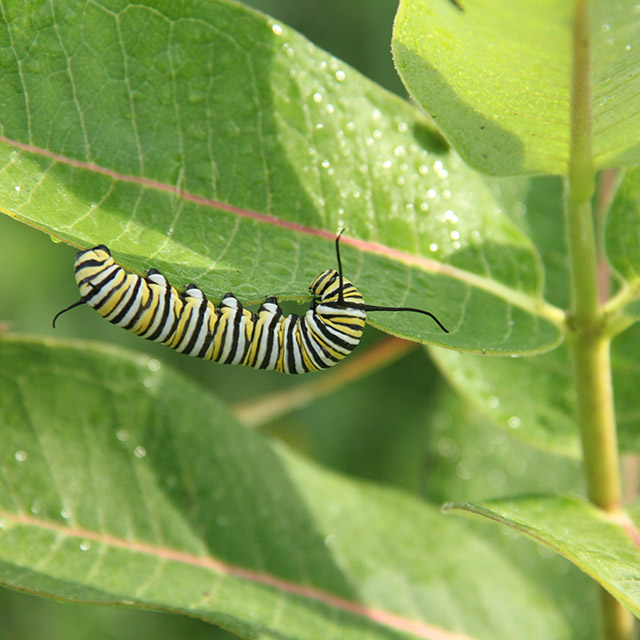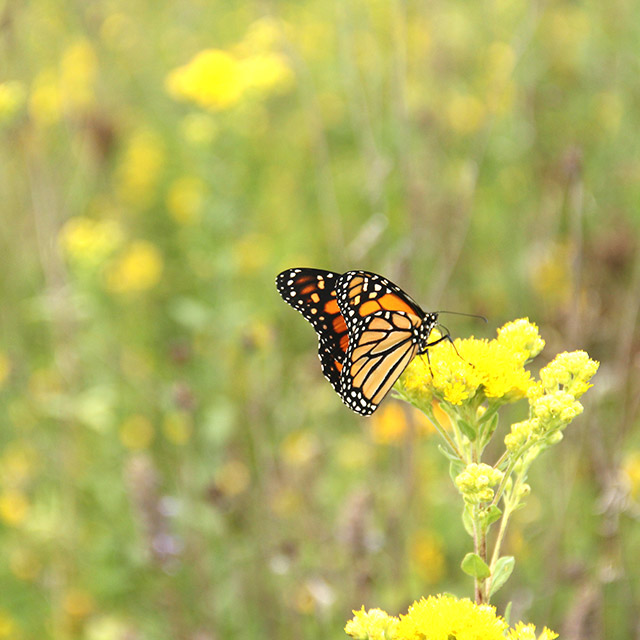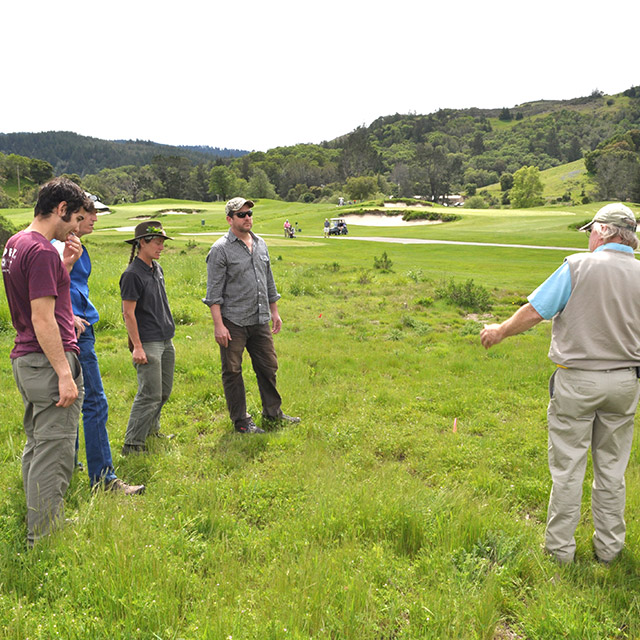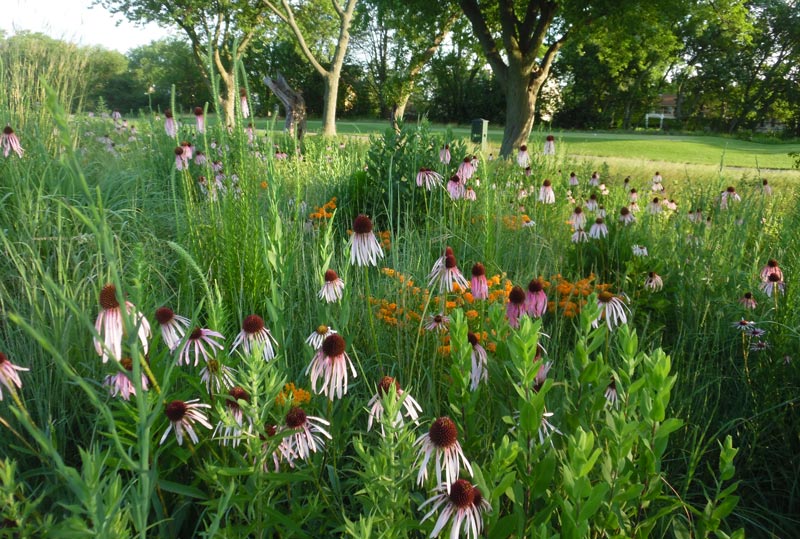Retrieved from: https://www.gcmonline.com/course/environment/news/reuse-bunker-sand-native-plants
Swapped-out bunker sand can be repurposed as a growing medium for native wildflowers and grasses, creating valuable habitat for insects and small animals.
April 30, 2020 | Dave Ward

A patch of wildflowers and grasses that thrive in sandy soil, grown in reused bunker sand at Coyote Run Golf Course in Flossmoor, Ill. The low-maintenance native areas do double-duty stewardship — recycling an otherwise discarded material and welcoming wildlife to the golfscape. The pinkish flowers are pale purple coneflower (Echinacea pallida). Photos by Dave Ward
Editor’s note: This article was originally published in the January 2020 issue of On Course, the monthly publication of the Midwest Association of Golf Course Superintendents.
With golfers demanding perfect playing conditions throughout the entire golf course, even bunkers, it’s rare that a golf facility hasn’t embarked on some sort of bunker renovation project, whether large or small. Bunker conditions that were perfectly acceptable 20 years ago would bring harsh criticism today. Golf facilities may initiate a variety of projects to bring bunkers up to today’s standards, including a total bunker renovation, a relocation, drainage improvements, recontouring bunker banks, or the installation of liners. Most projects entail replacing the old bunker sand, and this can be either an inconvenience or an opportunity.
When bunker sand is replaced, options for the disposal of the old sand are limited. One (expensive) approach is to have it hauled off-site. If the renovation work involves the use of large excavation equipment, the sand can be buried in the new bunker mounding or used to form berms in some other area of the course. Some courses have dump areas that can accommodate large volumes of waste materials.
Another solution — one that’s potentially environmentally friendly — is to reuse the sand to establish plots of prairie vegetation, which increases biological diversity and provides habitat and a food source for native animals and insects.
Coyote Run Golf Course in Flossmoor, Ill., was constructed in 2004 and opened in 2005. By the end of the first winter, a large portion of the bunker sand (which had met construction specifications but turned out to be too fine) had blown away. By the end 2006, our bunkers had stopped draining. In the fall of 2007, we initiated an in-house bunker reconstruction project, with the goal of renovating all 52 bunkers over a 10-year period.
The project included removing the old bunker sand, adding to and improving existing drainage, and installing geotextile liners followed by new bunker sand. During the first two-thirds of the project, sand removed from the bunkers was relocated to unrenovated bunkers in need of sand. Toward the end of the project, it no longer made sense to add sand to bunkers scheduled for renovation just to remove it in a year or two. We hit upon an economical solution to the disposal problem that also fit with Coyote Run’s native habitat and environmental initiatives: stockpiling the sand in out-of-play, unmowed fescue rough areas, and planting the sand with seed selected for dry or sand prairies.
We created four separate sand prairie plantings during each of the last four years of our 10-year bunker project. The process we used is similar to any other dormant-seeding project on a golf course. In late November, the stockpiled sand was graded into subtle mounds. Prairie seed — the “Butterfly Prairie for Dry Sandy Soils” seed mix from Prairie Nursery in Wisconsin (see below) — was mixed with the sand, and the mix was hand-spread over the planting area. We “dimpled in” the seed mixture with bunker rake tires, and then covered the area with straw erosion control blankets. While the seed was germinating, we would irrigate the planted area when conditions were dry. By the end of the following June, most of the seed had germinated, reducing the need for irrigation.



Prairie seed is blended with sand removed from Coyote Run’s bunkers during renovation work (top). The mix is seeded into an out-of-play area (middle), which is then covered with straw mat (bottom).
Each of the prairie plantings is between 4,000 and 5,000 square feet. The two we created in the first two years abut, forming a single area of about 8,000 to 10,000 square feet between the 15th and 17th tees. The two more recent plots are on the front nine — one near the second green, and one between the third and fourth holes.
Maintenance of these areas is similar to that of any other new prairie planting, though with less weed problems, as the sand is relatively free of weed seed. During the first year, mow the area at least three times at a height of 4 to 6 inches, to mow off any weed flowers and to allow sunlight to reach the sand, aiding the germination of the prairie seed. Avoid pulling weeds so as not to disturb the seedbed.
In the second year, mow the planting to a height of 10 inches when weeds are in flower but before they set seed. Prairie seeds will often germinate over a period of two to three years. Some will appear the first year, while others will come up in the second or even third year after the initial planting. Although a few plants might flower the first or second year, most perennial prairie flowers and grasses will not flower until their third or fourth full growing season.

Originally seeded to fescue, Coyote Run’s four sand prairie areas created using old bunker sand now provide blooms from mid-spring to late fall.
Once established, the plantings require very little maintenance — mostly controlling weeds once or twice a year, either manually or with a spot-sprayed herbicide. So far, I have been cutting down the dormant vegetation in late fall or early spring with a large mower, which takes almost no time. Eventually, we will leave the vegetation throughout the year, eliminating all mowing. The areas require no other maintenance, no water — in fact, it’s best for them to stay as dry as possible, as the plants are adapted to dry, sandy soil — and no fertilizer. I’d estimate I spend just two to three hours per year on each of the four areas.
Today, the first of our sand prairies has mature vegetation, a diverse plant mix and pleasing aesthetics. The last three plantings are in various stages of progression, on their way to becoming a beautiful part of Coyote Run’s native habitat. The sand prairie plots have attracted butterflies, bees, cicada killer wasps and goldfinches, who make the spaces their home or use them as a source of sustenance.
Even golfers, notorious for not seeing anything outside the field of play, notice and compliment the ever-changing flowers on the sand prairie areas as well as the wildlife that now graces them.
Butterfly prairie seed mix for dry, sandy soils
Wildflowers: Lavender hyssop, leadplant, butterfly weed, sky blue aster, smooth aster, white aster, lanceleaf coreopsis, purple prairie clover, pale purple coneflower, rough blazing star, lupine, bergamot, dotted mint, beardtongue, yellow coneflower, black-eyed Susan, wild petunia, stiff goldenrod, showy goldenrod, hoary vervain
Grasses: Sideoats grama, Canada wild rye, junegrass, little bluestem, prairie dropseed
Light: Full sun
Soil: Sand, loam
Moisture: Dry
Benefits: Pollinators, butterflies
Height: 2 to 5 feet
Per acre: 10 pounds
Per 1,000 square feet: 1/4 pound
This mix is available from Prairie Nursery in Westfield, Wis.
Dave Ward is the golf course superintendent at Coyote Run Golf Course in Flossmoor, Ill., where he has worked for 16 years. A graduate of the University of Illinois, Ward is a past president of the Chicagoland GCSA and the Illinois Turfgrass Foundation. He hosted the 1997 U.S. Senior Open and 2003 U.S. Open while superintendent at Olympia Fields (Ill.) Country Club. Ward is a 44-year member of GCSAA.











